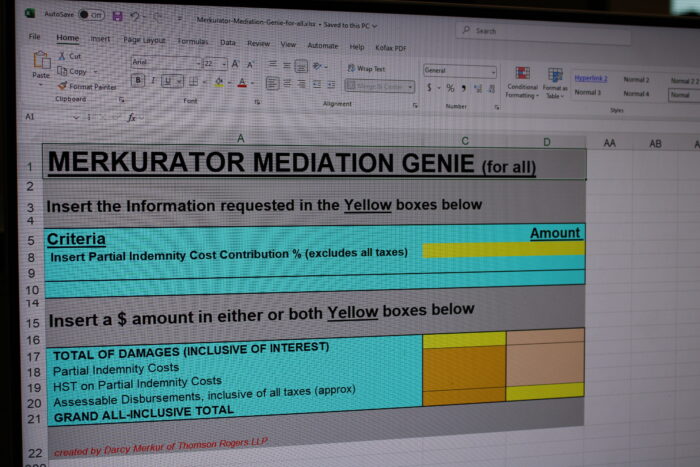How Car Accident Victims Can Access Treatment After Exhausting Their Accident Benefits
Author(s): Darcy R. Merkur
February 24, 2021

Motorists who are seriously injured in a car accident in Ontario regularly find themselves in the precarious and uncomfortable position of having exhausted the full amount of medical/ rehabilitation and attendant care benefits available from their accident benefit insurer yet still being in dire need of extensive ongoing treatment and care.
A number of unfortunate changes have been made to the Ontario No-Fault Accident Benefit System in the last several years that have interfered with and jeopardized the successful rehabilitation of seriously injured car accident victims. These changes include a major reduction in total benefits available and delayed access to the “catastrophic impairment” definition in brain injury cases. Combine those negative insurance changes with the early hospital discharges stemming from COVID-19 dynamics and you are faced with major rehabilitation challenges.
If somebody has suffered multiple fractures requiring surgeries or has a significant brain injury, they understandably require ample treatment and care. The accident benefit system provides that they have immediate access to $65,000 in combined medical/rehabilitation/attendant care benefits but, unfortunately, that amount is highly inadequate to address serious ongoing accident-related treatment and care needs.
Catastrophic Impairment Definition
Down the road, car accident victims have the potential to access the “catastrophic impairment” definition, where $1 million in benefits would be available. Under the current legislation, in most cases, access to the definition of catastrophic impairment is only readily available at the two-year anniversary of the accident.
In brain injury cases where the brain injury has been objectively validated, potential access to the catastrophic impairment definition can commonly be considered six months or a year post-accident, depending on the person’s recovery.
However, these temporal delays are much more significant than just stated, given that once you get past the waiting periods to access the test, you still have to go for the assessments and await the reports. Then you have to face the reality of attending the catastrophic impairment insurer examinations that will follow, causing a further several-month delay before you even know whether the insurer will accept your entitlement to the catastrophic impairment benefits!
As a result, those with serious, primarily orthopedic injuries must typically wait roughly three years post-accident before they actually obtain the catastrophic impairment designation, assuming things go smoothly. If they end up in a debate with their car insurer about the definition of catastrophic impairment, such that a dispute with the Licence Appeal Tribunal is warranted, then they are looking at another year-long delay or more.
In brain injury cases, the timeline may be quicker because the brain injury test can often be accessed six months or one year after the accident, but you still end up with the assessment process and the insurer examinations that follow thereafter such that it is often close to two years post-accident before the insurer accepts a catastrophic impairment determination. And again, if a dispute is warranted, then you can add another year to the equation, making it an approximate three-year waiting period before you receive the catastrophic impairment designation, even in brain injury cases.
During that lengthy time span, the injured person only has access to the $65,000 available from their accident benefit insurer, causing havoc for their rehabilitation and undue stress on both them and their families.
Trauma lawyers do whatever they can to expedite matters and persuade the accident benefit insurer to simply accept the catastrophic impairment designation without dispute. That often helps speed things up, but still, a large number of seriously injured motorists are in a jam for an extended period while they have exhausted their non-catastrophic benefits.
When Non-Catastrophic Accident Benefits Have Been Exhausted
Where the non-catastrophic accident benefit limits have been exhausted, trauma lawyers and their health providers must work on solutions to ensure the client’s safety and active rehabilitation wherever possible. Those solutions include the following:
1. Self-Funded by the Clients
One option is for the accident victim to fund any necessary treatment and care with hopes of recovering those costs from the accident benefit insurer if they later obtain the catastrophic impairment definition or in any viable lawsuit that will be advanced on their behalf. Unfortunately, this option is not realistic as most accident victims are understandably in financial distress resulting from their inability to work and their extensive care needs.
2. Seek an Extension of Benefits
The trauma lawyer should try to push the accident benefit insurer to extend benefits beyond the non-catastrophic limits for the well-being of their insured, especially when a catastrophic impairment designation is anticipated.
Most insurers refuse to extend funding, arguing that they have no legal basis to do so, although importantly, they do have a duty of good faith to their insured and should seriously consider these requests whenever possible as the consequences of not extending funding can be disastrous for their insured’s successful recovery (and somewhat ironically increase the changes the injured person will meet the catastrophic impairment test without having had adequate treatment).
3. Tort Advanced Payment
If the accident victim has a lawsuit against an at-fault party, their trauma lawyer should demand an advanced payment from the at-fault party’s insurer based on the exhaustion of the non-catastrophic policy and their need for ongoing services.
The terms of that advance payment should be that no legal fees whatsoever will be charged out of such advance and that the advance payment would be used solely on rehabilitation and care needs, with particulars of how the funds are spent being provided to the defendant’s insurer.
Where liability is clearly on a defendant and where the needs are plain and obvious, many insurance adjusters and their defence lawyers do try to help in this regard. However, the extent of the advance is often inadequate to solve any long-term issues.
4. Protected Accounts
The most common solution, although it should be a last resort, is to seek instructions from the client to “protect” accounts of providers to be paid upon the successful resolution of the claims.
This involves the trauma lawyer seeking instructions from the client to ensure that healthcare providers are paid if and when the cases are successfully resolved. In other words, the healthcare provider would agree to be paid when and if the cases are resolved successfully.
Importantly, the instructions should come from the client and should be relayed through the lawyer.
My practice is, where appropriate, to have my client provide written instructions essentially saying that they hereby irrevocably direct me to ensure that the named health provider is paid for services provided if they successfully resolve their claims up to a fixed maximum. I always include a maximum debt so that the debt does not get out of hand over time. Of course, that maximum can be increased as the situation evolves, but it is important to have a maximum in place to avoid a situation where the debt accumulates to everyone’s surprise. In those circumstances, I ask providers to keep the client (and me) updated on the extent of debt by monthly or quarterly invoices, depending on the extent of services provided. I also continue to ask providers to submit treatment and assessment plans even though they will be denied so that we can push the accident benefits insurer to fund any treatment received despite the denial if and when the catastrophic impairment designation is obtained. Lastly, I would alert the insurer in the lawsuit of the protected accounts and let them know that we are holding them responsible for those debts and any interest payable in relation thereto.
5. Litigation Loans
Some companies will loan money to accident victims in these circumstances. The rates charged are extremely high, and therefore, the loan should be discouraged wherever possible.
When a loan is considered and required, the trauma lawyer should alert the defence lawyer of the need for a loan, given their failure to make an advance payment. This way, the trauma lawyer can demand that the defendant pay for all the hefty interest charges.
I sympathize with accident victims who have exhausted their non-catastrophic funding and with healthcare providers who are forced to go out on a limb and work under protected accounts. Our system, unfortunately, puts us in a position where these situations are quite normal.
Finally, in my view, the accident victim should always continue to access required treatment, especially early on post-injury, as doing so is vital to their rehabilitation. I hate seeing an accident victim reduce the frequency of their treatment simply to make sure they will have funding available later. I always try to find other solutions to avoid them having to make that tough decision.
At Thomson Rogers, we have spent decades assisting thousands of injured Ontario accident victims. Thomson Rogers offers free consultations, so please feel free to reach out to us at any time. We are here to help.
Darcy Merkur is a highly regarded Ontario trauma lawyer helping accident victims such as pedestrians, cyclists and motorists who have sustained catastrophic injuries.
Darcy is the first lawyer in Canada to be qualified as a Certified Brain Injury Specialist by the Brain Injury Association of America. In addition, Darcy has been recognized as a Certified Specialist in Civil Litigation by the Law Society of Ontario, is listed in peer-reviewed publications – Lexpert® and The Best Lawyers™ in Canada, is ranked AV pre-eminent in Martindale-Hubbell ® and is a partner at Thomson Rogers, one of Canada’s Top 10 Personal Injury Law Firms as selected by Canadian Lawyer Magazine.
Darcy can be reached at 416-868-3176 or by EMAIL.
Share this






